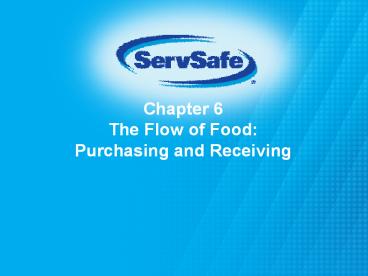Chapter 6 The Flow of Food: Purchasing and Receiving - PowerPoint PPT Presentation
1 / 15
Title:
Chapter 6 The Flow of Food: Purchasing and Receiving
Description:
Chapter 6 The Flow of Food: Purchasing and Receiving Checking the Temperatures of Various Types of Food Meat, Poultry, and Fish Insert the thermometer stem or probe ... – PowerPoint PPT presentation
Number of Views:80
Avg rating:3.0/5.0
Title: Chapter 6 The Flow of Food: Purchasing and Receiving
1
Chapter 6The Flow of Food Purchasing and
Receiving
2
Checking the Temperatures of Various Types of Food
- Meat, Poultry, and Fish
- Insert the thermometer stem or probe into the
thickest part of the food (usually the center)
3
Checking the Temperatures of Various Types of Food
- ROP Food (MAP, vacuum-packed, and sous vide food)
- Insert the thermometer stem or probe between 2
packages - As an alternative, fold packaging around the
thermometer stem or probe
4
Checking the Temperatures of Various Types of Food
- Other Packaged Food
- Open the package and insert the thermometer stem
or probe into the food
5
Receiving and Inspecting Guidelines
- Guidelines
- Have enough trained staff available to promptly
receive, inspect, and store food - Authorize staff to accept, reject, and sign for
deliveries - Have policies and procedures for rejecting
deliveries
6
Receiving Temperatures
- Temperature Criteria for Deliveries
- Receive cold TCS food at 41F (5C) or lower,
unless otherwise specified - Receive hot TCS food at 135F (57C) or higher
- Receive frozen food frozen
7
Packaging
- Reject items with
- Tears, holes, or punctures in their packaging
likewise, reject cans with swollen ends, rust, or
dents - Broken cartons or seals or dirty wrappers
- Leaks, dampness, or water stains
- Signs of pests or pest damage
- Expired code or use-by dates
8
Product Quality
- Reject food if
- It has an abnormal color
- It has an abnormal or unpleasant odor
- Reject meat, fish, or poultry if
- It is slimy, sticky, or dry
- It has soft flesh that leaves an imprint when
touched
9
Receiving and Inspecting Specific Food
- Eggs
- Eggs must be clean and unbroken when you receive
them - Shell eggs must be received at an air temperature
of 45F (7C) or lower - Liquid, frozen, and dehydrated egg products must
be pasteurized as required by law and have a USDA
inspection mark eggs also must comply with USDA
grade standards
10
Receiving and Inspecting Specific Food
- Milk and Dairy Products
- Must be received at 41F (5C) or lower, unless
otherwise specified by law - Must be pasteurized and comply with USDA grade A
standards
11
Receiving and Inspecting Specific Food
- ShellfishRaw Shucked
- Make sure that raw shucked shellfish are packaged
in nonreturnable containers - Containers must be labeled with the packers
name, address, and certification number - Containers smaller than one-half gallon (1.9 L)
must have either a best if used by or sell by
date - Containers bigger than one-half gallon (1.9 L)
must have the date the shellfish were shucked
12
Receiving and Inspecting Specific Food
- ShellfishLive
- Receive with shellstock identification tags
- These tags must remain attached to the delivery
container until all the shellfish have been used - Employees must write on the tags the date that
the last shellfish was sold or served from the
container - Operators must keep these tags on file for 90
days from the date written on them - Reject shellfish if they are very muddy, have
broken shells, or are dead
13
Receiving and Inspecting Specific Food
- Produce
- Sliced melons and cut tomatoes must be received
at 41F (5C) or lower - Prepackaged Juice
- Prepackaged juice must be purchased from a
supplier with a Hazard Analysis Critical Control
Point (HACCP) plan - The juice must be treated (e.g., pasteurized) to
prevent, eliminate, or reduce pathogens
14
Review
- Time for Review
15































